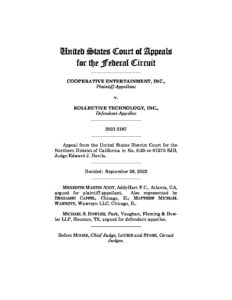By Erik Swanson
The Federal Circuit recently in Cooperative Entertainment v. Kollective Technology reversed a district court’s granting of Kollective’s motion to dismiss Cooperative’s patent infringement complaint under Rule 12(b)(6) of the Federal Rules of Civil Procedure. Applying the two-step analytical framework for assessing patent-eligibility under the U.S. Supreme Court’s 2014 Alice decision, the Federal Circuit held that there existed sufficient factual disputes to preclude dismissal under Rule 12(b)(6) .
Cooperative sued Kollective for infringement of Cooperative’s U.S. Patent No. 9,432,452, which is directed to systems and methods of structuring a peer-to-peer (P2P) dynamic network for distributing large files, such as videos and video games. The claimed dynamic P2P network comprises “peer nodes” that consume the same content contemporaneously and transmit the content directly to each other, instead of receiving content from an outside content distribution network (CDN) as in the prior art. Kollective defended by filing a pretrial motion to dismiss Cooperative’s complaint under Rule 12(b)(6) on the grounds that all claims of the ‘452 patent constitute patent-ineligible subject matter under § 101 of the U.S. patent statute (35 U.S.C. § 101). Specifically, Kollective alleged that the claims are directed to the abstract idea of “the preparation and transmission of content to peers through a computer network,” and do not require any patent-eligible inventive concept, and are therefore ineligible under Alice. The district court agreed with Kollective, and Cooperative appealed to the Federal Circuit.
According to the Supreme Court’s Alice analytical framework, in assessing patent-eligibility under § 101, the first step is to determine whether the claims at issue are directed to one of the three judicial exceptions to patent-eligibility (laws of nature, physical phenomenon, or abstract ideas). If so, the second step is to determine whether additional elements of the claim are sufficient to transform the nature of the claim into an eligible application of the judicial exception. Additional elements can suffice to transform a claim where there is an “inventive concept” which is more than merely implementing the abstract idea using “well-understood, routine [and] conventional activities,” or otherwise ensure that the claim in practice amounts to “significantly more” than a patent on an ineligible concept.
On appeal, the Federal Circuit found no need to resolve the “abstract idea” question dictated by Alice step 1. Sidestepping Alice step 1, the Federal Circuit asserted that it “need not address” the question because “the claims contain alleged invention concepts not limited to the abstract idea” and therefore satisfy Alice step 2. In analyzing Cooperative’s patent claims under Alice step 2, the Federal Circuit found that the patent claim language itself, the written description and the allegations set forth in Cooperative’s complaint together create a plausible factual record regarding the inventiveness of the claimed dynamic P2P configuration. Claim 1 recites a specific type of content-sharing network and delineates both network structure and function, the court asserted. The patent’s written description explains how the claimed invention is different from and improves upon the prior art. In particular, the patent specification details how the claimed invention provides “more efficient and reduced cost of delivery for the content” and enables new content delivery system functionality by “providing live streaming for video and/or audio content as well as data, files, analytics, and combinations thereof.” The complaint reiterates the benefits of the claimed “novel technique” of a dynamic P2P network for distributing content outside the control of a CDN, and the complaint’s allegations are “plausibly tethered” to the claim language. Determining whether Cooperative’s claimed network is well-understood, routine or conventional is thus a question fact that cannot be resolved at the Rule 12(b)(6) stage, the Federal Circuit emphasized. The district court erred in resolving this factual issue against Cooperative—the non-moving party, the Federal Circuit concluded.
In the wake of the Supreme Court’s 2014 Alice decision, Rule 12(b)(6) motions to dismiss on the grounds of patent-ineligibility have become a common defensive tactic employed by accused patent infringers. The Cooperative decision demonstrates that such motions can be defeated by claims reciting specific structure and function that improve on earlier approaches, supported by adequate disclosure in the specification of how the particular arrangement of claim elements provides advantages over the prior art, as well as allegations in the complaint tied to the claim language. Notably, Cooperative permits a court to find potentially abstract claims patent-eligible without reaching a conclusion under step 1 of the Alice analytical framework.


